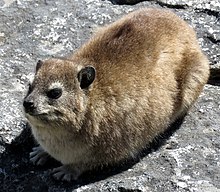| Procavia | |
|---|---|

| |
| Rock hyrax (Procavia capensis) | |
| Scientific classification | |
| Domain: | Eukaryota |
| Kingdom: | Animalia |
| Phylum: | Chordata |
| Class: | Mammalia |
| Order: | Hyracoidea |
| Family: | Procaviidae |
| Genus: | Procavia Storr, 1780 |
| Type species | |
| Cavia capensis [1] Pallas, 1766
| |
| Species | |
Procavia is a genus of hyraxes. The rock hyrax (P. capensis) is currently the only extant species belonging to this genus, though other species were recognized in the past, including P. habessinica and P. ruficeps, both now relegated to subspecific rank.
Several fossil species are known as well, the oldest dated to the Early Pliocene, including:
- †Procavia antiqua (syn. Procavia robertsi)[2]
- †Procavia pliocenica[3][4]
- †Procavia transvaalensis (syn. Procavia obermeyerae)[2]
References
- ^ Wilson, D. E.; Reeder, D. M., eds. (2005). Mammal Species of the World: A Taxonomic and Geographic Reference (3rd ed.). Johns Hopkins University Press. ISBN 978-0-8018-8221-0. OCLC 62265494.
- ^ a b Werdelin, Lars; Sanders, William Joseph (2010). Cenozoic Mammals of Africa. University of California Press. pp. 142–143. ISBN 9780520257214.
- ^ Pickford, M. (2005). "Fossil hyraxes (Hyracoidea: Mammalia) from the Late Miocene and Plio-Pleistocene of Africa, and the phylogeny of the Procaviidae". Palaeontologia Africana. 41: 141–161.
- ^ Haile-Selassie, Yohannes (2009). Ardipithecus Kadabba: Late Miocene Evidence from the Middle Awash, Ethiopia. University of California Press. p. 106. ISBN 9780520254404.
External links










